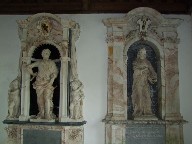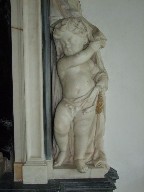| |
|
 |
|
It was an early summer day,
about ten years ago. West Suffolk was in
full leaf, and I cycled along the Glem
Valley from Hartest,
looking for this church. The trees
thickened, until the road was lined with
woodland as much as fields. A sign
pointed off eastwards: Boxted Church
1/4 mile. I think it was perhaps the
longest quarter of a mile that I've ever
cycled, steeply uphill and out into the
countryside again. The church is hidden
by trees, and the lane up to it comes as
a surprise, at a corner. The setting is
fairly typical for this part of west
Suffolk, the rolling valley falling away
to the east and a great country house
somewhere below. Rede, the highest point
in the county, is the next parish along.
Slow sheep cropped the grass beyond the
hedge, and eyed me lazily. I
came back to Boxted on a frosty day in
the late October 2009, the sun at last
out dispersing the mist we had walked
through across the Chadacre estate, and I
was pleased to be back in this strange,
beautiful place.
|
Despite its location, All Saints is
one of the better known parish churches of
Suffolk, and we will see why in a moment. But
from the outside it does look unfamiliar, for to
the north side of this pretty medieval church is
a large, boxy red brick aisle and
chapel, with few windows, and the curious domed
smokestack of a chimney rising from one corner.
Flint in the walls suggests that there was an
earlier north aisle here. What on earth has
happened? Well, this is the early 18th Century
work of the Poley family, the Booxted Lords of
the Manor. At the moment of swapping time for
eternity, they have become frozen in time here.
If you go inside, we can see them.
When I first came this way I was
young and fiery, and rather dismissive of grand
monuments. I have grown to admire much of the
post-Refomation work in East Anglia's churches;
but I suppose that I still feel a bit
uncomfortable with the way that, from the
mid-16th century onwards, our churches were
usurped for a show of family power, often with
monuments that are the height of vulgarity. Of
course, there were grand memorials before the
Reformation, particularly in brass. But these
seem to have retained a sense of piety, an
acknowledgement of the family's participation in
the economy of grace, as well as that of land and
money. In the 18th Century in particular,
memorials intend to demonstrate secular power,
and are often wholly pagan in character.
Medieval churches often had chantry
chapels for local landed families, where they
could be buried and have Masses said for their
souls in what they believed would be perpetuity.
These chapels often became the mausoleum or
private aisle for the family once the Reformation
had declared prayers for the dead to be useless.
Occasionally, the churches where these great
families remembered themselves became entire
private chapels - Hengrave, for
example, which became a mausoleum for a recusant
Catholic family. But most often, as at Helmingham, Framlingham and here
at Boxted, they continued as Parish churches
after the Reformation.
But Boxted is slightly different.
What makes Boxted remarkable is that the family
that glorified itself here, the Poleys, did so
rather late, and in the late 17th and early 18th
centuries seem to have attempted to recreate a
16th century mausoleum church by building a fake
pre-Reformation chantry chapel. Why did
they do this? Probably, to try and make it look
as though they were a more established family
than they might have appeared otherwise. So they
built the north chapel to the chancel, certainly
the only one built in the whole of Suffolk in
either of those centuries. Probably, the attempt
to make it look like an ex-chantry chapel is
based on the same (but genuine) thing at nearby Somerton. At this
time, antiquarians were beginning to rediscover a
fascination with the past; late 16th and 17th
century church architecture normally reaffirms
and celebrates the Reformation and its break with
the past. As I say, at the Reformation the
chantry chapels often became family mausoleums;
and so, the Poleys created their own.
Apart from the extensive late
17th/early 18th century work, this church was
thoroughly restored again during the 19th
century. There's never been a shortage of money
here. Virtually all the woodwork is 19th century,
although the pulpit is older,
and so is the chancel roof. From the 16th century
is Boxted's earliest tomb, on the south side of
the chancel. This is most striking, and it is
only when you get up close that you see the jet
black effigies are not marble at all, but wood.
The oak has blackened with age. This is a rare
revival of the wooden effigies popular in the
13th century, and found in Suffolk at Heveningham and Bures. This one
is to William and Alice Poley, and was made after
1587.

 
The chancel floor is paved in ledger
stones for various Poleys. To the north is the
Poley mausoleum itself, and the grand statues are
of Sir John Poley, who died in 1638, and Dame
Abigail his wife, who died in 1652.
Interestingly, the statues are much later than
these dates, Sir John's being made in 1680 and
Dame Abigail's as late as 1725, which probably
dates the chapel which now houses them.
  




There are later members of the same
family remembered in the chancel: a south side
window remembers Edward and Ursula
Hallifax-Weller-Poley. The window depicts St
George and St Francis above medallion portraits
of the couple. Sir Edward is shown in WWI
uniform, and Ursual in the costume of an Anglican
nun, which she became after her husband died in
1948. She founded the Company of St Francis in
Gateshead.
Their son Hugh was
killed at the age of 20 in the Second
World War, and the good modern east
window remembers him, depicting Christ in
Glory standing above Boxted parish, the
church and the Hall set among scenes of
animals and birds.The opening above the
chancel arch seems an echo of the one at Polstead,
and is intriguing. I wondered if it had
something to do with the rood, but it was
only put in in the 1890s, at the same
time as the medieval canopy of honour was
taken out - an extraordinary act at so
late a date, and one that can perhaps be
put down to the local Big House getting
its own way.
This is a beautiful
and fascinating place, but it must be
said that here is less a sense of the
numinous here than in some other medieval
churches. Continuity was fractured, and
the Poleys' work removed this church from
the liturgical and devotional context in
which it was built. But here is an
important document of one landed family's
act of memory, and it is worth seeing for
that alone.
|
|
 |
|
|
|

